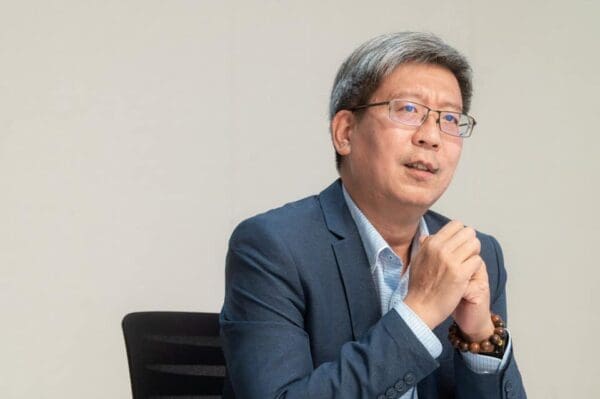BLOG
How ASUS is Building Leadership in Sustainable Technology: A Conversation with TS Wu
ASUS’s Chief Sustainability Officer shares how the brand’s “Engineering Spirit” shapes its ESG strategy.
In the face of increasingly complex compliance requirements and growing economic turbulence, a robust ESG strategy has become indispensable for a company’s growth. While today’s corporations often operate in structured and specialized siloes, a successful ESG strategy requires heightened collaboration across all stakeholders in order to find solutions to complex challenges. In our work, we found that companies prioritizing ESG initiatives often excel at identifying innovative solutions to unlock growth opportunities.
Global technology brand ASUS has long been an industry leader in ESG strategies and sustainable growth. In 2021, ASUS furthered its efforts by launching the “2025 Sustainability Goals,” committing to 100% renewable energy usage by 2035. As part of this initiative, ASUS worked with Prophet to deepen its ESG strategy and narrative. In January 2023, ASUS released its new ESG slogan at CES – “Sustaining an Incredible Future.”

Cecilia Huang, a former partner at Prophet, sat down with TS Wu, chief sustainability officer of ASUS Group, to discuss how ASUS imbues a strong purpose and ESG strategy into its organizational culture to drive uncommon growth.
CH: In recent years, the technology industry emphasizes more sustainable growth while confronting various challenges, such as compliance requirements and market shifts. What measures has ASUS taken to overcome these challenges as well as elevate its ESG strategy?
TW: I have seen in the past few years that societal topics such as environmental protection have become increasingly mainstream, and ESG strategies and organizational resilience are more valued. However, there are still many challenges that businesses need to identify and solve urgently. Externally, meeting compliance standards and consumer demands to remain competitive requires rapid iteration; internally, organizations face issues such as talent retention, innovation, brand building, and profitability.
In order to meet these challenges and effectively integrate ESG, ASUS has implemented three major initiatives:
- First, from “maximizing the interests of stockholders” to “maximizing the value for stakeholders”: In the past, ASUS focused on maximizing stockholder value. But now, we recognize that for a business to achieve long-term success, it must meet the expectations of all stakeholders.
- Second, from “emphasizing technology” to “emphasizing purpose”: The guidance of organizational culture is crucial. Chairman Jonney Shih has always insisted on promoting ASUS’ “authentic and pragmatic” culture internally. He once shared the book, The Heart of Business by Hubert Joly, former CEO at Best Buy, which advocates for leadership and business that starts from the heart. Such a culture allows ASUS employees to focus less on external awards and recognition and more on the original intent and vision of the company. We have been following this philosophy to garner enthusiasm towards ESG, building our strategy from the inside out.
- Third, from “passively avoiding risks” to “actively achieving sustainable growth”: In the past, our focus for ESG has been on risk reduction and legal compliance. Now we are going a step further, with an eye on brand growth and adapting to the future. We’re working to proactively create shared value through the development of ESG strategies that promote sustainable growth.
CH: When did ASUS’s commitment to ESG begin? What experiences can you share from what ASUS has learned over the years?
TW: ASUS has undergone six stages towards developing our ESG strategy. Starting in 2002 the seeds of ESG were planted at ASUS. Customers began paying more attention to product sustainability. We set up Green ASUS under the Quality Assurance Center to meet the demands of the market and our customers. Subsequently, in 2008, ASUS established the ASUS Foundation to invest more actively in social impact programs in order to improve our corporate image and reputation.
The turning point was in 2010 when ASUS transitioned from passive involvement into active efforts. We proposed standards for ourselves that were higher than industry regulations and sought to bring more environmentally friendly products to customers, with the aim of gaining a greater competitive advantage and penetrating a broader international market. In 2016, we went a step further and embedded sustainability as a parameter in product design, process transformation, organizational design, supply chain management and other processes, formally incorporating ESG into our strategy.
Now, based on the existing foundation and achievements, we are exploring how ESG can become an important pillar of our company’s future strategic growth.
After undergoing the six stages of ESG transformation, we understand how to deal with various challenges and recognize the importance of making ESG a core strategy on its own. By setting up a dedicated department and adding the role of chief sustainability officer, we’ve created a culture that allows different departments across the company to understand the importance of ESG, enables experts to help advise on and implement initiatives, and deeply roots ESG within ASUS.
CH: You mentioned that ASUS’s leadership places great importance on the original intent of the company. What role do they play in driving ESG across the organization?
TW: I believe the role of leaders in the early stages of ESG development is far greater than in the later stages. Leaders can guide the organization early on and ensure its implementation is not just a superficial branding project.
At ASUS, our chairman and CEO both lead by example, personally participating in the ESG committee to discuss ASUS’s sustainable business strategy and philosophy. Employees understand that the leadership greatly values ESG Therefore, each department incorporates ESG accordingly and soon sees the benefits of ESG in building the business, thus forming a positive feedback loop.
Different departments will invite the sustainability team to participate in their strategic planning with the hope that the success of new products will not only come from new functionalities but also from the sustainable features in product design. To us, this signifies real change.
CH: ASUS’s “Engineering Spirit” is unique. How does it relate to ESG initiatives? How do the two influence each other?
TW: “Engineering Spirit” is the DNA of ASUS’s organizational culture, and our ESG strategy is connected to it in two ways.
The first is data-based measurement and technology-centric management. This means that the benefits of sustainability-related actions can be evaluated and managed through quantifiable indicators. Taking environmental profit and loss assessment as an example, ASUS quantifies the air pollution, water pollution, greenhouse gas, and waste pollution generated throughout the process of laptop computer production. This allows us to understand the environmental impact of suppliers in each segment of the value chain and helps us optimize resource allocation. In addition, this initiative allows us to clearly convey to stakeholders ASUS’s emphasis on sustainable growth and the value it brings to society through real and visible figures.
The second is design thinking. In this realm, we pursue the concept of “beautiful, practical, and environmentally friendly,” and incorporate products’ design, weight, thinness, and ESG dimensions into product parameters. We resolve conflicts through technology and design thinking to find the optimal solution.
As a result, the focus on sustainability has permeated ASUS’s product design, process design, organizational design, and supply chain management. Its importance is highly valued at each stage of the process.
CH: Lastly, in terms of organizational management, how should companies build a better future through improved organizational processes, values, and talent development?
TW: I believe a shift in strategic and operational thinking is key. While competition is inevitable, a change in mentality is essential. Organizations in the past emphasized the division of labor and efficiency, but ESG-led organizations emphasize collaboration and connection. Therefore, ASUS’s ESG department plays the role of a facilitator and guide across the organization, rather than a commander. We never require other departments to replicate successful cases. Instead, we use them as experience sharing and a knowledge base, so that each team can reasonably choose resources and invest pragmatically based on real business conditions, ultimately promoting sustainable growth across the company. Externally, ASUS also cooperates with other technology companies to launch a Climate Partnership, with the goal of working jointly on issues that cannot be solved by a single company.
Furthermore, talent is indispensable to ESG. We do two things to cultivate our talent development. First, we encourage independent innovation. In our organizational design, ASUS gives individuals greater autonomy to foster innovation. Second, we cultivate interdisciplinary talent. We believe that it is very important to develop employees that can coordinate and integrate different domains, especially for ESG-oriented organizations. As an organization, we are committed to shaping our employees from specialists into generalists, connecting fragmented knowledge and creating higher value.
Finally, establishing values is very important. To quote our chairman: “Long-term profitability is the standard by which the market measures the success of a company. What truly outstanding companies have in common is that they have a clear business philosophy and consistent values, and they know how to communicate with key stakeholders. When an organization can think deeply, redefine the role of sustainability, and use its unique core capabilities to meet the needs of the environment and society, the performance of the company will be even more outstanding.”
FINAL THOUGHTS
As shown in our conversation with TS Wu, the key to driving a successful ESG strategy to realize transformational growth lies not only in technological innovation and brand story but also in holistic planning across multiple strategic dimensions, including brand purpose, organizational management and collaboration.
For business leaders, the starting point is to ensure the right mindset that focuses on creating value for all shareholders, building a purposeful business and actively driving sustainable growth. It is important to take a long-term view to transform the organization and culture with a strong purpose. If done right, an ESG-led strategy can align the company and become the central force for unleashing uncommon, sustainable growth.
Prophet brings its strengths in consumer understanding, business model design, reimagining brands and experiences, and change readiness to help companies take the next step. Contact us to discuss how to build a growth-oriented ESG strategy.

